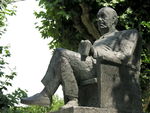Camilo José Cela
| Camilo José Cela Marquess of Iria Flavia |
|
|---|---|
 |
|
| Born | Camilo José María Manuel Juan Ramón Francisco Javier de Jerónimo Cela Trulock May 11, 1916 Padrón, Galicia, Spain |
| Died | January 17, 2002 (aged 85) Madrid, Spain |
| Resting place | Iria Flavia Cemetery |
| Language | Spanish |
| Nationality | Spanish |
| Genres | Novels, Short Stories, Essays |
| Literary movement | Tremendismo |
| Notable work(s) | La familia de Pascual Duarte, La colmena |
| Notable award(s) | Nobel Prize in Literature 1989 |
| Spouse(s) | María del Rosario Conde Picavea (m. 1944) Marina Castaño (m. 1991) |
| Children | Camilo José |
|
Influences
Francisco de Quevedo, Pío Baroja
|
|
Camilo José María Manuel Juan Ramón Francisco Javier de Jerónimo Cela y Trulock,[1] 1st Marquess of Iria Flavia (11 May 1916 - 17 January 2002), commonly known as Camilo José Cela (Spanish pronunciation: [kaˈmilo xoˈse ˈθela]), was a Spanish novelist and short story writer. In 1989, he won the Nobel Prize in Literature.
Contents |
Biography
Camilo José Cela was born on 11 May 1916 in the locality of Iria Flavia, Padrón, in the north-western region of Galicia, Spain to Camilo Cela Fernández (1881-1959) and Camila Manuela Trulock y Bertorini (1895-1975). Before he became a professional writer, Cela attended the University of Madrid, where he briefly pursued a law degree. He also fought in the Spanish Civil War on the side of Franco, until he was wounded by an errant grenade and discharged. After the war, Cela dedicated himself to newspaper work and took several jobs of an essentially bureaucratic nature, including a position of censor that would later bring him criticism. In 1944 he married María del Rosario Conde Picavea with whom he had a son, Camilo José Cela Conde, 2nd Marquess of Iria Flavia, in 1946.
Cela published his first novel, La Familia de Pascual Duarte (The Family of Pascual Duarte), when he was 26, in 1942. Pascual Duarte has trouble finding validity in conventional morality and commits a number of crimes, including murders, for which he feels nothing. In this sense he is similar to Meursault in Albert Camus's novel The Stranger. This novel is also of particular importance as it played a large part in shaping the direction of the post-war Spanish novel.
He published two travel books Viaje a la Alcarria (Journey to La Alcarria, 1948), and Del Miño al Bidasoa (From Minho to Bidasoa, 1952).
Cela's best known work, La Colmena (The Hive) was published in 1951, featuring more than 300 characters and a style showing the influence of both Spanish realism (best exemplified by Miguel de Cervantes and Benito Pérez Galdós) and contemporary English- and French-language authors, such as Joyce and Sartre. Cela's typical style—a sarcastic, often grotesque, form of realism—is exemplified in La Colmena. It should be also noted that, as with some of his other works in this period, La Colmena was first published in Argentina, as Franco's Roman Catholic Church-affiliated government banned it because of the perceived immorality of its content.
From the late 1960s, with the publication of San Camilo 1936, Cela's work became increasingly experimental. In 1988, for example, he wrote Cristo versus Arizona (Christ versus Arizona), which tells the story of a duel in the OK Corral in a single sentence that is more than a hundred pages long.

In 1957 he was appointed a member of the Real Academia Española. Cela was also created Marquis of Iria Flavia by King Juan Carlos I. He was appointed Royal Senator in the Constituent Cortes, where he exerted some influence in the wording of the Spanish Constitution of 1978.
In 1989, he was awarded the Nobel Prize in Literature for a rich and intensive prose, which with restrained compassion forms a challenging vision of man's vulnerability.[2]
In his later years he was infamous for his scandalous outbursts: he boasted in an TVE interview with Mercedes Milá about his capability to absorb a litre of water via his anus, offering to demonstrate[3]. He had already scandalized Spanish society with his Diccionario secreto ("Secret Dictionary", 1969–1971), a dictionary of slang and taboo words.
He described the Spanish Cervantes Prize as "covered with shit"[4]. Subsequently, he was awarded the prize in 1995.
In 1994, he was awarded the Premio Planeta. Some question the objectivity of the awards, and winners on occasion have refused to accept it.
In recognition of his contributions in literature, Cela was ennobled on 17 May 1996 by King Juan Carlos I, who gave Cela the hereditary title of Marqués de Iria Flavia (English: Marquis of Iria Flavia) in the nobility of Spain. On his death the marquessate passed to his son Camilo José Cela Conde.
Death
Cela died from heart disease on 17 January 2002 at the Hospital Cemtro in Madrid, aged 85. He was laid to rest in the parish cemetery of Santa María de Adina.
His will was contested because he favoured his widow, and second younger wife. Marina Castaño over his son Camilo José Cela Conde, from a previous marriage.
Ancestry
| Ancestors of Camilo José Cela | ||||||||||||||||||||||||||||||||||||||||||||||||||||||||||||||||||||||||||||||||||||||||||||||||||||||||||||||||||||||||||||||||||||||||||||||||||||||||||||||||||||||||||||||||||||||||||||||||||||||||||||||||||||||||||||||||||||||||||||||||||||||||||||||||||||||||||||||||||||||||||||||||||||||||||||||||||||||||||||||||||||||||||||||||||||||||||||||||||||||||||||||||||||||||||||||||||||||
|---|---|---|---|---|---|---|---|---|---|---|---|---|---|---|---|---|---|---|---|---|---|---|---|---|---|---|---|---|---|---|---|---|---|---|---|---|---|---|---|---|---|---|---|---|---|---|---|---|---|---|---|---|---|---|---|---|---|---|---|---|---|---|---|---|---|---|---|---|---|---|---|---|---|---|---|---|---|---|---|---|---|---|---|---|---|---|---|---|---|---|---|---|---|---|---|---|---|---|---|---|---|---|---|---|---|---|---|---|---|---|---|---|---|---|---|---|---|---|---|---|---|---|---|---|---|---|---|---|---|---|---|---|---|---|---|---|---|---|---|---|---|---|---|---|---|---|---|---|---|---|---|---|---|---|---|---|---|---|---|---|---|---|---|---|---|---|---|---|---|---|---|---|---|---|---|---|---|---|---|---|---|---|---|---|---|---|---|---|---|---|---|---|---|---|---|---|---|---|---|---|---|---|---|---|---|---|---|---|---|---|---|---|---|---|---|---|---|---|---|---|---|---|---|---|---|---|---|---|---|---|---|---|---|---|---|---|---|---|---|---|---|---|---|---|---|---|---|---|---|---|---|---|---|---|---|---|---|---|---|---|---|---|---|---|---|---|---|---|---|---|---|---|---|---|---|---|---|---|---|---|---|---|---|---|---|---|---|---|---|---|---|---|---|---|---|---|---|---|---|---|---|---|---|---|---|---|---|---|---|---|---|---|---|---|---|---|---|---|---|---|---|---|---|---|---|---|---|---|---|---|---|---|---|---|---|---|---|---|---|---|---|---|---|---|---|---|---|---|---|---|---|---|---|---|---|---|---|---|---|---|---|---|---|---|---|---|---|---|---|---|---|---|---|---|---|---|---|---|---|---|---|---|---|---|---|---|---|---|---|---|
|
||||||||||||||||||||||||||||||||||||||||||||||||||||||||||||||||||||||||||||||||||||||||||||||||||||||||||||||||||||||||||||||||||||||||||||||||||||||||||||||||||||||||||||||||||||||||||||||||||||||||||||||||||||||||||||||||||||||||||||||||||||||||||||||||||||||||||||||||||||||||||||||||||||||||||||||||||||||||||||||||||||||||||||||||||||||||||||||||||||||||||||||||||||||||||||||||||||||
References
- ↑ "Cela: 20 años de un Nobel, 27 de un bulo". http://www.elcomerciodigital.com/20091025/cultura//cela-anos-nobel-bulo-20091025.html.
- ↑ Nobel prize citation
- ↑ Todos los títulos fueron suyos, Luis Ventoso, La Voz de Galicia, 18 January 2002.
- ↑ La leyenda del gran provocador, Ángel Vivas, El Mundo, 18 January 2002.
External links
- BBC obituary
- Biography of Camilo José Cela
- Photos
- The Nobel Foundation has a site on him, including speeches, biography and bibliography.
| Spanish nobility | ||
|---|---|---|
| New title | Marquis of Iria Flavia 1996–2002 |
Succeeded by Camilo José Cela Conde |
|
||||||||